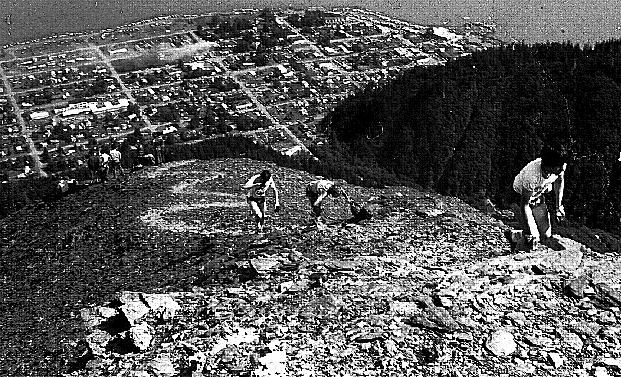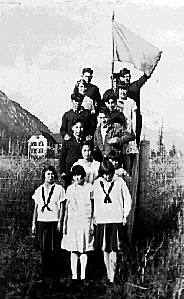

As the khaki streak bolted down Main Street, those who knew the whole story shouted themselves hoarse. But bystanders didn't have to know everything to get caught up in the excitement. Children on bicycles escorted the grinning runner through town. Soon adults too fell in behind the procession.
The race is Seward's now famous annual marathon up a peak originally called Lowell Mountain. The first running occurred in 1915 after, legend has it, a barroom bet. Could the mountain be conquered in one hour? Some said yes, others no, but both sides were willing to put money up front. Not much, though. Just enough to make the stakes interesting. The winner made it in sixty-two minutes. He lost the bet, but started a tradition that eventually changed the mountain's name and made Seward's race one of the oldest and most unusual foot races in the country.
The runner in khaki described above was only fourteen years old, an Aleut boy born in Chignik, in Prince William Sound. At the time, he lived at the Jesse Lee Home, a Seward orphanage. Clad in his Boy Scout uniform, looking fresh and rested, with a grin a mile wide and his heart singing, he slipped under the rope to win the Mount Marathon Race that Fourth of July in 1928.

Ephriam Kalmakoff - "Epheem" to his friends - had smashed the record, whacking more than two minutes off the 1916 run held by Alec Bolan. Epheem's new record would stand until Sven Johanssons's 1957 run, and the fourteen year old is still the youngest race champion. Epheem had defeated experienced racers, past winners, grown men. And this year - 1928- the race committee had changed the starting line to Fourth Avenue and Washington Street, so the boy had actually run a longer race by at least three blocks than the previous record holder.
Epheem was the topic of conversation the evening of July 4, 1928, and his humility and boyish grin captivated the town. It didn't take long for people to learn the whole story, why Epheem had to run this race and win it. It had been a matter of principle.
He had planned to run the year before and started working out that spring. The Seward Gateway even followed his progress: "It is understood that Ephriam Kalmakoff, a Jesse Lee boy, will take a whirl at the pot of gold," they reported. "Unknown to anyone, this young lad has been consorting with mountain goats for the past ten days." His practice runs were good and he knew he had a chance at victory, so Epheem signed up for the race.
What an honor he could bestow on the Jesse Lee Home, an orphanage and residential care facility for Alaska Native youth. That spring his friend Benny Benson had won a contest to design the Alaska Territorial Flag, and the legislature had just adopted it. Epheem could now give his home another prize.

But July 4th fell on a Tuesday in 1927, and weekend visitors begged the town to hold the race on the Sunday before. At the last minute, the race committee agreed. On Saturday, the day before the race, Epheem walked into the office at Jesse Lee Home.
"They say the race will be run tomorrow," he said. "What shall I do?" Epheem had been taught that such Sabbath Day activities were forbidden. "You are old enough to decide that," he was told. "Do what you think is right."
So Epheem did what he thought right. He didn't run the race that July 2nd in 1927. he knew he could win it. But he had principles and he believed in them.
The Methodist Episcopal Church ran the Jesse Lee Home, and one of their national secretaries happened to be visiting Seward. Mrs. Anne Hobbs Woodcock of the Woman's Home Mission Society heard about Epheem's decision, and was impressed. "I think I could win," he had told her. "But not on Sunday. I'll try next year."
Later that summer, while on a coast-to-coast speaking tour, Mrs. Woodcock told the story of the boy who didn't run the race. In Dayton, Ohio, a woman stood up with a dollar bill in her hand. "No boy loses anything by being true to his principles," she said. "Let this dollar be the first of one hundred to be sent to Epheem." That Christmas, Epheem received a check for one hundred and fifteen dollars from the Methodist women of Dayton.
But then the skeptics started gossiping. "How do you know he could have won, or even come in second or third," they scoffed. People shook their heads. People murmured. Epheem didn't say much, but he knew what he had to do.
That spring of 1928, he started working out with a passion. As soon as it was safe to climb the mountain, he began practice runs. Rumors circulated about the fourteen-year-old Aleut boy from Jesse Lee Home, the one who had entered the race last year but hadn't shown up. This year Epheem would make his intentions clear. On June 20th, he became the first entrant to sign up for the race. Word spread that his practice times were already faster than the winning times for the last five years.
At 6:30 p.m. on July 4, 1928, seven runners bolted up Main Street toward the mountain and disappeared into a tree line shrouded in dense and shifting mists. The runners wore foot-square numbers on their backs so observers could use binoculars to keep the crowd updated. But the mountain kept its secret for nearly fifty-two minutes until Epheem came bounding down through the mountain mists toward the finish line.

Jesse Lee Home officials quickly wired Mrs. Woodcock: "Ephriam won first place in Mount Marathon STOP broke all previous records STOP finished in 52:35." That night Jesse Lee's children celebrated with a special supper of hot cocoa, sandwiches, ice cream and cookies.
"I was bettin' on him," said Benny Benson, who would finish second behind Epheem in 1929. "How much did you bet?" someone asked. "Aw, gee. I didn't bet money," Benny answered. "I just knew he could do it."
For the next three years, Jesse Lee boys dominated the race. They were the only entrants and they took first, second and third places. No one even dared compete against them. Epheem grabbed first place again in 1929 and 1930, becoming the first runner in the history of the race to win three consecutive competitions.
Shortly after his last win, Epheem developed tuberculosis. After a lingering illness, he died in 1935. Many people at the time believed his Mount Marathon training and running had contributed to Kalmakoff's disease. Some claimed that was one reason the race was discontinued for several years. They called it "Kalmakoff's Curse."
Ironically, the eighth and last victory by a Jesse Lee Boy was won by Epheem's brother, Inekente, in 1944. But it would be many years before people forgot that record-shattering race of 1928, and its humble victor, Ephriam Kalmakoff.
On July 5, 1928, Epheem went back to his routine at Jesse Lee Home. That afternoon he hoed peas and onions in the garden. But he wore a grin and his heart was singing.



 Jesse Gifford at
Portalis@hotmail.com
Jesse Gifford at
Portalis@hotmail.com